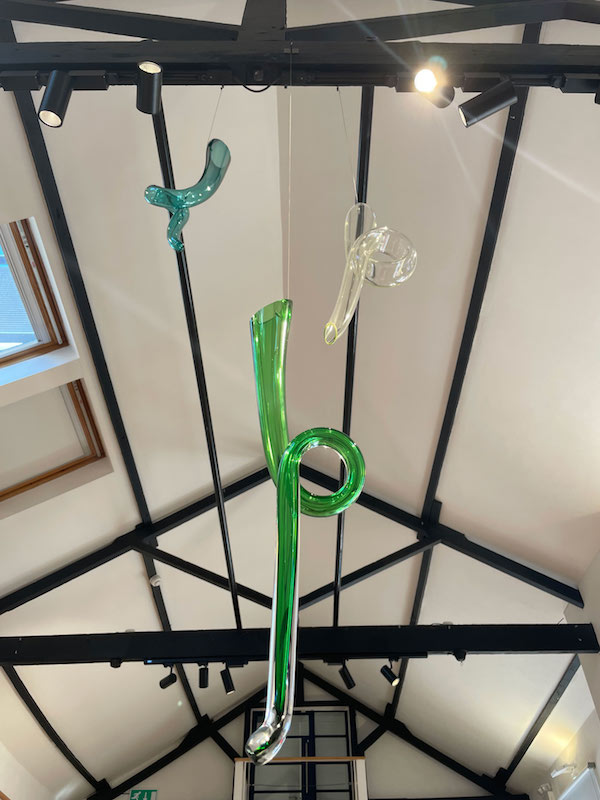One of the notable characteristics of The Cello Factory is its copious natural light making it the perfect space for the “Reflection” exhibition, and the show has unique qualities that set it apart. Many of the works aim to intrigue the visitor through their surfaces and colours changing as one’s viewpoint moves, while others transform according to the changing light in the gallery and some do both.
This exhibition is a journey like the sunlight that moves across the space of the gallery.
In the entrance, Andrea V Wright works with the layering of semi-opaque latex sheets and LED lighting – almost like looking into a wardrobe.
Cross Sections, by Fiona Grady, is an intervention created by fixing vinyl onto the windows. Light projects coloured shapes onto the floors and walls of the gallery, moving with the time of day and position of the sun. Pieces by Paul Bonomini made of polished steel take on a different appearance as changing colours cause a lively response, and the reflections positively glow in Christine Wood’s subtly beautiful circular wall piece.

Suspended above the exhibition, Michael Petry’s glass mobile consists of three hand-blown glass sculptures clinging as icicles might. Frozen light, fragile as well as translucent and a constant reminder of the all-seeing eye.
The blackness of Susan Gunn’s work appears to soak up colour, with black surprisingly being the most reflective colour, seen most markedly in obsidian mirrors. Sibéal Colley and Alison Goodyear explore fluorescent paint, and the paintings spring to life with remarkable vibrancy under ultraviolet lighting.
The natural pearlescence of Anna Reading’s beautiful and delicately fragile oyster shells is echoed in the Nebula series by Alexander Hinks using resin with iridescent pigment to create extra luminosity. Another piece by him, “Beaming”, with metallic paint, explores inner and outer space using an aerial map entwined with abstract forms.
In Anna Lytridou’s sculptures, copper sheets are painted on one side, and the work reflects itself in the exposed copper on the reverse. Paul Tecklenberg’s corner piece also reflects itself, extending its perimeters, and in Alexandra Harley’s sculpture a painted shadow defines a framework.
In the work of Sirpa Pajunen-Moghissi, floral formations are frozen and trapped into layers of perspex and resin. Essentially an extension of collage techniques with the advantage of raising and separating the images and making them float. Simon Pike also uses layered techniques to explore mechanical and digital ways to create images aided by vinyl printing. This increases and heightens the intensity of the imagery and explores opacity as a way of flattening the overall effect. This is reversed when we look at the work of Charley Peters, who creates space that causes objects to overlap and float.
Sumi Perera takes architecture as a reflective component. A small part of this ambitious piece is a collection of spheres that contain trapped imagery and miniature reflections of the whole space.
There are three pieces in the exhibition that deal with digital light. Susan Haire’s projection unfolds itself in the way that kaleidoscopes do when moved and is gently calming to watch. This is also true of Genetic Moo’s Bog, a strange piece that feels like a heat-seeking device that the police use to spot living and moving beings. The dots on the screen follow you around the space and fix themselves like iron filings to a magnet. If you become too relaxed and stay still for too long, you could get covered. Watch out!
Two works that evoke a powerful mood are the third digital work, Christina Augustesen’s lightbox, which slowly pulsates and breathes as a living Rothko, growing and changing and the resplendent evening glow of the photograph by Judith Jones with its rich contrast between hot and cold colours.
This exhibition is a journey like the sunlight that moves across the space of the gallery. Reflection has a double meaning, of light and images, and also of memory and thought, and this show subtly weaves between the two, and it is the experience and vision of the curator, Alexander Hinks, which makes the whole show coherent and adventurous.
“Light is not so much something that reveals, as it is itself a revelation”. James Turrell.
Words: Dave Stephens Photos: Alexander Hinks ©Artlyst 2021
Reflection, The Cello Factory 10-21 October 2021, Free
Visit Here

